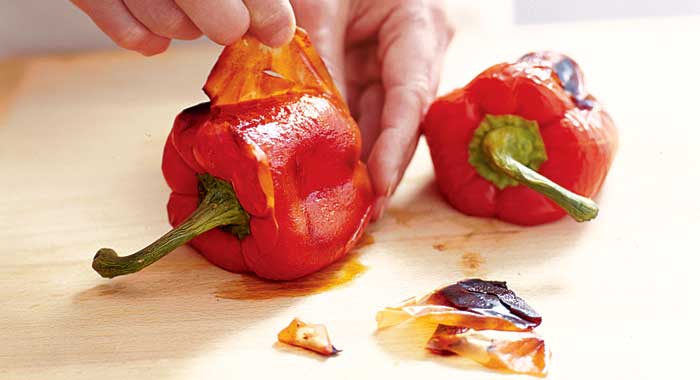
Pronounce it: pep-iz
Also known as capsicums, bell peppers, sweet peppers or by their colours, for example red and yellow peppers.
These are a non-hot member of a large family that varies enormously in size, shape, flavour and heat content and that includes all the chilli peppers.
Green peppers are the unripe state of red peppers and are the most aggressively flavoured, being vegetal, acidic and a little bitter, traits that soften with cooking. Once ripe and red, peppers are gentler and sweeter in flavour and far more use raw or cooked, although it’s common to use red and green peppers together.
Yellow and orange peppers are individual varieties rather than stages between green and red peppers, and both of these were specially bred to be sweet and gentle.
Purple peppers have a slightly stronger flavour but will turn green when cooked.
Availability
One sort or another is usually available fresh year round. Canned and bottled peppers are excellent if preserved in brine or oil but less useful if preserved in vinegar or other acid.
Choose the best
Peppers have a very long life, particularly when refrigerated. Check for puckering around the stalk end or wrinkling of the skin as early signs of ageing.
Prepare it
However you want to slice up a pepper, you always need to remove the core, pith and seeds. To skin peppers, lay them on a foil-lined grill pan and turn the grill to high. Turn them now and again until the skin is blackened all over, then put them in a bowl and cover with cling film, or seal in an airtight plastic bag. When they’re cool, their skin can be peeled off easily with your fingers.
Store it
Peppers are best kept chilled and out of the light.
Cook it
To peel or not to peel. That is a major question. Peppers are unquestionably even nicer to eat when skinned, which can be done by charring over a flame or by pouring on boiling water. Both methods are fiddly and time-consuming, especially when skinned red peppers are so easily and cheaply available in bottles and tins; skinned Spanish piquillo peppers are a great storecupboard addition.
Whether using raw or to cook, peppers should be cut from top to bottom in large slabs and then the pale inner vertical membranes removed, as these are always bitter.
Because they’re acceptable eating when raw, pieces of pepper that are only part cooked add colour, juiciness and crunch to stir-fries, when the short heating time will soften them without fully cooking.
Otherwise, whether stuffed and roasted, gently fried in olive oil (with garlic of course) or similarly simmered in (tinned) plum tomatoes as a side dish or added to casseroles, fully cooked peppers add reliable flavour, colour and satisfaction.
Rings of any colour of pepper are something that should remain in the recipes of past decades, because cutting them like this means the bitter inner membranes have not been removed.
Alternatives
Try chilli.
Be the first to comment on "Pepper"